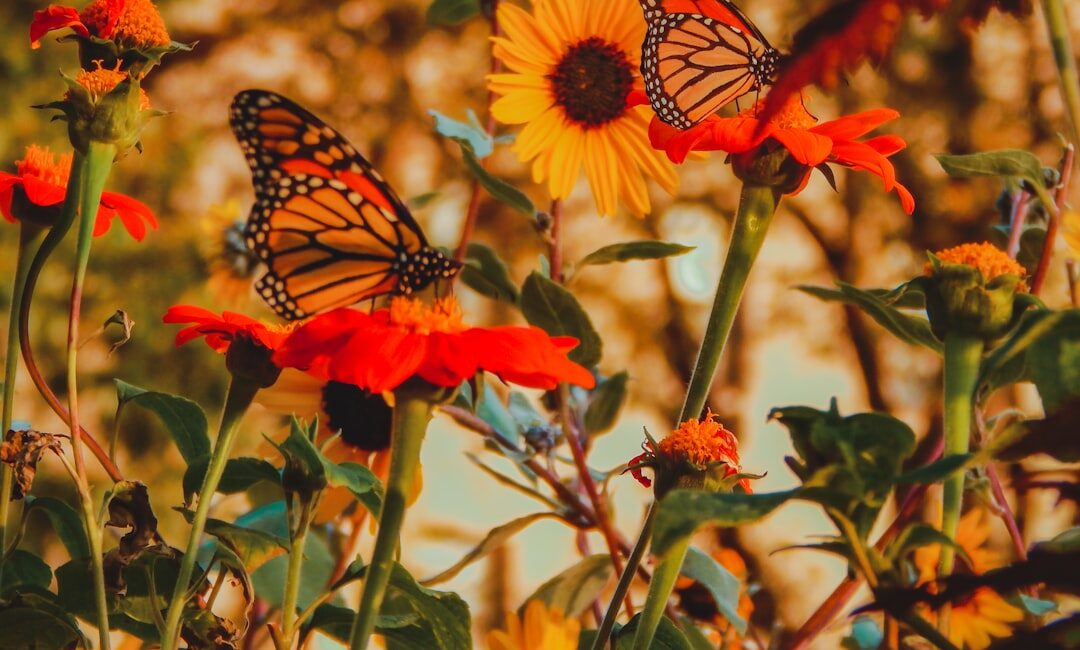What if a simple patch of flowers could transform your backyard into a living kaleidoscope of color and movement? A butterfly garden does more than beautify—it breathes life into outdoor spaces, offering a sanctuary for pollinators and a front-row seat to nature’s delicate dance. This article explores how to create a thriving habitat for butterflies, from selecting the right plants to providing shelter and water. Whether you have a sprawling yard or a modest balcony, these practical steps will help you craft a space that attracts and sustains these winged wonders. Let’s explore how small changes can make a big difference for both butterflies and gardeners alike.
Understanding Butterfly Needs

Creating a successful butterfly garden begins with understanding the fundamental needs of these delicate pollinators, which extend beyond just colorful flowers. Butterflies require specific environmental conditions, including ample sunlight for warmth, sheltered areas to escape strong winds, and access to both nectar sources for adults and host plants for their larvae. For example, species like monarchs rely heavily on milkweed as a host plant, while swallowtails prefer plants like parsley or dill. By recognizing these key aspects of their lifecycle—from feeding to reproduction—gardeners can design spaces that support butterflies at every stage. This foundational knowledge ensures the garden not only attracts visitors but also sustains future generations of these vital pollinators.
Understanding the specific needs of butterflies is essential for creating a garden that supports their life cycle. Butterflies rely on host plants for laying eggs and nurturing caterpillars, while adult butterflies depend on nectar-rich flowers for sustenance. Providing a variety of plants that bloom at different times ensures a continuous food source throughout the season. Additionally, butterflies require shelter from wind and predators, such as shrubs or tall grasses, to feel secure. By incorporating these elements into your garden design, you create a habitat that not only attracts butterflies but also supports their survival. With these practical steps, your outdoor space can become a thriving haven for these delicate pollinators, setting the stage for the next step: selecting the ideal garden location.
Selecting Nectar-Rich Plants

Creating a successful butterfly garden starts with selecting nectar-rich plants that cater to the dietary needs of adult butterflies. These plants serve as a primary food source, providing the essential energy butterflies require for flying, mating, and egg-laying. When choosing plants, it’s important to focus on varieties with abundant nectar production and flowers that are easily accessible to butterflies. Native species, such as milkweed, coneflowers, and black-eyed Susans, are particularly effective because they have evolved alongside local butterfly populations, making them more attractive and beneficial. By incorporating a mix of these plants, gardeners can create a reliable and sustainable nectar supply that supports a diverse range of butterfly species.
When selecting nectar-rich plants, gardeners should prioritize varieties with flat or clustered blooms, such as coneflowers, zinnias, or milkweed, which provide easy access for butterflies to feed. Planting in staggered groups rather than single specimens creates visible targets for pollinators and ensures a reliable food source. For practical application, include plants with varying bloom times—early spring options like lilacs, summer-blooming butterfly bushes, and fall favorites like goldenrod—to support butterflies throughout the season. A simple trick is to observe which native flowers attract butterflies naturally in the area, then incorporate those species into the garden design. This approach not only sustains local butterfly populations but also reduces maintenance, as native plants typically adapt well to regional soil and climate conditions.
Providing Host Plants for Caterpillars

Host plants are essential for a butterfly garden, as they provide the primary food source for caterpillars, enabling them to grow and eventually transform into butterflies. Unlike nectar plants that attract adult butterflies, host plants are specific to each butterfly species, as their caterpillars rely on particular foliage for survival. For example, milkweed is indispensable for monarch caterpillars, while parsley and fennel are favored by swallowtails. Including these plants in a garden not only supports the life cycle of butterflies but also helps sustain local ecosystems. By understanding the connection between specific host plants and butterfly species, gardeners can create a habitat that fosters both beauty and biodiversity.
When selecting host plants for caterpillars, it’s essential to consider both the species you hope to attract and the practicality of maintaining them. For example, monarch butterflies rely exclusively on milkweed, while swallowtails prefer plants like parsley, dill, or fennel. Gardeners should plant these in clusters to make them easier for female butterflies to locate and avoid treating them with pesticides, as even organic options can harm delicate larvae. A simple yet effective strategy is to designate a specific area of the garden for host plants, allowing caterpillars to feed undisturbed while keeping the rest of the space vibrant with nectar-rich blooms. By thoughtfully integrating these plants, gardeners not only support the butterfly life cycle but also create a dynamic ecosystem where every stage of growth thrives.
Creating Shelter and Sunbathing Spots

Butterflies need more than just nectar-rich flowers to thrive; they also require shelter and sunbathing spots to complete their life cycle successfully. Providing such spaces helps protect butterflies from harsh weather conditions, predators, and offers them areas to warm their wings. A well-designed butterfly garden includes elements like tall grasses, shrubs, or small trees that act as natural windbreaks, as well as flat, sunlit surfaces such as rocks or paving stones where butterflies can bask in the sun. These features not only enhance the garden’s functionality but also create a balanced habitat that supports butterflies throughout their daily activities. Understanding these key aspects ensures that the garden becomes a sustainable haven for these delicate creatures.
To create effective shelter and sunbathing spots, gardeners should incorporate flat stones or light-colored rocks in sunny areas, as butterflies rely on these warm surfaces to regulate their body temperature. Planting shrubs like Buddleia or tall grasses near these sunning spots provides nearby refuge from predators and sudden weather changes. For practical application, position these features near nectar-rich flowers to create a seamless habitat—butterflies will alternate between feeding and basking without expending unnecessary energy. A shallow dish filled with sand or pebbles can also serve as a dual-purpose sunning and puddling station, particularly when placed in a sheltered yet sunny corner. By thoughtfully combining these elements, the garden becomes a functional haven that supports butterflies throughout their daily activities, setting the stage for the next crucial step: selecting the right plants to sustain them.
Avoiding Pesticides

Creating a butterfly-friendly garden begins with understanding the harmful effects of chemical pesticides on these delicate pollinators. Many common insecticides, even those labeled as “broad-spectrum,” can inadvertently kill butterflies at all life stages—from eggs to adults—disrupting the ecosystem gardeners aim to support. Neonicotinoids, a widely used class of systemic pesticides, are particularly dangerous as they remain in plant tissues and nectar long after application. Beyond direct toxicity, pesticides can eliminate host plants by destroying the very caterpillars that mature into butterflies, creating a ripple effect in the garden’s biodiversity. By recognizing these risks, gardeners can make informed choices to protect butterflies while still managing pests responsibly.
Beyond simply eliminating chemical pesticides, gardeners can adopt natural alternatives to protect plants while keeping butterflies safe. Introducing beneficial insects like ladybugs or lacewings helps control pests without harming caterpillars or adult butterflies. Physical barriers such as row covers or hand-picking pests offer effective, non-toxic solutions. For stubborn infestations, organic remedies like neem oil or insecticidal soaps—applied sparingly and in the evening when butterflies are less active—minimize harm to pollinators. These practical approaches ensure a balanced ecosystem where butterflies thrive alongside healthy plants, paving the way for a garden that supports biodiversity at every stage of a butterfly’s life cycle.
Seasonal Planting for Continuous Attraction
Creating a butterfly garden that remains vibrant throughout the year requires careful planning with seasonal planting, ensuring a steady supply of nectar and habitat for these delicate pollinators. Butterflies rely on blooming flowers from early spring to late fall, so incorporating plants with staggered flowering periods—such as crocuses and violets in spring, coneflowers and milkweed in summer, and asters and goldenrods in autumn—keeps the garden attractive across seasons. Understanding regional climate and plant hardiness zones is crucial, as some species thrive in cooler months while others peak in summer heat. By selecting a diverse mix of native plants, gardeners can provide consistent resources, supporting butterflies through every stage of their lifecycle while maintaining visual interest in the landscape.
To ensure a steady stream of butterfly activity, gardeners should plan their plantings with seasonal blooms in mind. For spring, consider early bloomers like bloodroot or violets, which provide essential nectar after winter. Summer gardens thrive with vibrant options such as coneflowers and milkweed, while fall can be extended with late-flowering plants like goldenrod and asters. Additionally, incorporating plants with staggered blooming periods ensures that food sources are always available, even during transitional months. Practical applications include grouping plants with similar bloom times together and regularly monitoring the garden to see which species attract the most butterflies. By understanding and implementing seasonal planting strategies, gardeners not only support butterfly populations year-round but also enjoy a dynamic, ever-changing landscape.
Creating a Butterfly Watering Station
Butterflies, like all living creatures, need water to survive, but their delicate anatomy requires specialized hydration methods. A butterfly watering station provides a safe and accessible way for these winged visitors to drink, particularly in hot or dry conditions where natural water sources may be scarce. Unlike birds or mammals, butterflies cannot drink from deep containers; instead, they prefer shallow puddles or damp surfaces where they can extract moisture without the risk of drowning. Gardeners can create an effective watering station by using a shallow dish filled with sand or pebbles and adding just enough water to keep the surface moist. This setup mimics natural puddling areas where butterflies gather to absorb minerals and hydrate, making it an essential feature in any butterfly-friendly garden.
When setting up a butterfly watering station, practical considerations ensure its effectiveness. A shallow dish filled with pebbles or sand and just enough water to create damp spots allows butterflies to safely perch and drink without drowning. Placing the station in a sunny yet sheltered spot near nectar-rich plants increases its visibility and accessibility. Gardeners should refresh the water regularly to prevent stagnation and avoid deep containers, which pose a drowning risk. For added benefit, a pinch of sea salt or compost can be mixed into the water to provide essential minerals butterflies seek. By incorporating these simple yet thoughtful details, a watering station becomes a functional and inviting feature in any butterfly garden, seamlessly supporting the next step: designing an optimal garden layout.
Attracting Monarchs Specifically
Monarch butterflies, with their striking orange-and-black wings, are among the most recognizable and beloved pollinators, but their populations have declined due to habitat loss and pesticide use. To attract these iconic insects, gardeners must prioritize milkweed, the only plant monarch caterpillars eat, alongside nectar-rich flowers like coneflowers, goldenrod, and asters to sustain adults. Unlike general butterfly gardens, monarch-specific habitats require careful plant selection and placement, as these butterflies rely on specific host plants for reproduction. Understanding their migratory patterns—particularly in North America—helps gardeners time plantings to support monarchs during their spring and fall journeys. By focusing on these key aspects, even small gardens can become critical waystations for monarch conservation.
To create a monarch-friendly garden, prioritize planting milkweed varieties, the sole host plant for monarch caterpillars, such as Asclepias tuberosa or Asclepias incarnata. These plants not only provide essential food for larvae but also serve as nectar sources for adult butterflies. Gardeners should avoid using pesticides, as even organic options can harm monarchs at various life stages. For practical application, cluster milkweed with other nectar-rich flowers like coneflowers and goldenrod to create a staggered bloom schedule, ensuring food availability throughout the season. Leaving some leaf litter undisturbed in fall offers overwintering shelter for chrysalises, while a shallow water source with wet sand or stones helps hydrate adult butterflies. By implementing these specific practices, gardeners can play a direct role in supporting monarch populations while enjoying their vibrant presence in the landscape.
Key Takeaways
To create a thriving butterfly garden, it’s essential to provide ample sunlight, sheltered areas, and access to nectar-rich flowers and host plants, such as native species like milkweed, coneflowers, and black-eyed Susans. Eliminate harmful chemical pesticides and opt for natural alternatives like beneficial insects or organic remedies to protect butterflies while managing pests responsibly. Incorporate seasonal planting with a mix of native plants that provide nectar and habitat across different seasons, and create a butterfly watering station with shallow water and damp surfaces. Prioritize planting milkweed varieties and nectar-rich flowers to support monarch populations, and provide shelter from wind and predators with shrubs or tall grasses. By thoughtfully integrating these elements, gardeners can create a balanced ecosystem that supports butterflies throughout their life cycle, sustaining future generations of these vital pollinators and fostering a deeper connection with nature.
Conclusion
Designing a butterfly garden is more than just a creative project—it’s a way to bring life and beauty to your outdoor space while supporting local ecosystems. By carefully selecting plants that caterpillars and adult butterflies thrive on and ensuring a variety of blooming seasons, you can create a sustainable haven for these pollinators. A well-planned garden not only enhances your surroundings but also fosters a deeper connection with nature. With thoughtful design and minimal effort, your butterfly garden will become a flourishing, vibrant retreat for years to come.





